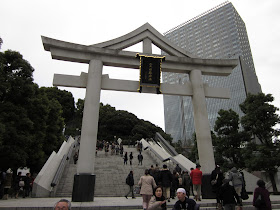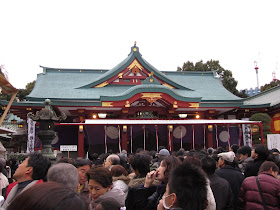Our next Hatsumōde stop is at Hie Shrine (日枝神社, ひえじんじゃ). Hie Shrine is in Nagata in the Chiyoda Ward of Tokyo. It is actually very close to where I stayed during my time here as a study abroad student, but oddly enough I never visited the shrine during my time there and this would be my first visit.
Hie Shrine has it's beginnings in the early Kamakura period (1185-1333) on the current site of the Emperor's Palace. (I will be getting more into the history of Edo Castle and the Emperor's Palace in my next post, so if this is of interest then be on the lookout for it.) A man named Edo had built a Hie Shrine here to house the guardian deity of his property. The deity in Hie Shrines is Ōyamakui-no-kami, which is the God of Mt. Hie in Shiga Prefecture; it is more commonly known as Hie-no-kami. [1] Shiga Prefecture can be found on the 4th map of my Maps of Japan post. Ōyamakui-no-kami is the master of the great mountain and look over the growth of everything, especially business. [2] Hie Shrine's next development would come in 1478 when Ota Dokan built Edo Castle in the same spot and built Sanno-Hie Shrine to house the guardian deity for the castle. When Iyeasu Tokugawa took over Edo Castle to rule over Edo and Japan as Shogun, he also gave patronage to the shrine and made it a protector of the city of Edo. Now the guardian deity of the Shogun, it greatly increased the importance of Hie Shrine and its following from the local people. [3]
Hidetada Tokugawa, 2nd Shogun of the Tokugawa Shogunate moved the shrine in 1607 to near the present day National Theater instead of inside the castle grounds, because citizens of Edo could only visit the shrine two days of the year while it was in the castle grounds. However this didn't last long as the shrine burned down in a fire along with most of the city in 1657. When it was rebuilt in 1659, the shrine was moved to its current location. These shrines buildings were designated as national treasures until they were unfortunately also lost to fire, this time to the air raids of World War II. The present shrine was rebuilt in 1958 with donations from worshipers of the shrine. [4]
While Hie Shrine is not the most famous of shrines for Hatsumōde, my girlfriend suggested we go because of their wide variety of New Year's Ema for sale. I have talked previously about ema and collecting them, when I talked about my trip to Enoshima and buying the ema here. Before the ema, I'll show the shrine experience up to that point.
 |
| The torii leading up to Hie Shrine. The shrine is on top of the hill in the area, so there are a lot of steps to the top. |
 |
| The main building of Hie Shrine decorated for New Year's. |
 |
| Looking back at the entrance of the inner gate. |
We actually didn't make our wishes or pray at this shrine as the line was very long (over an hour wait) and there were no back ways in like Meiji Jingū. We were also running out of time in the day and still had things to do. However, we did participate and watch several of the New Year's festivities at the shrine.
 |
| Speaking of sake, here is the sake offerings given to Hie Shrine. This is what the sake offerings usually look like, with a full cask given. This is actually a very common sight at shrines. |
 |
| We also watched this ceremony at the shrine. The shrine maiden takes the protection charms that the worshipers have bought from the shrine and then prays to the gods for extra protection from them. |
 |
| A closer view of the smaller ema. |
As you can see, almost all of the ema have rabbits on them. That's because this is the year of the rabbit (usagi in Japanese, うさぎ). Japan still puts importance in the Chinese Zodiac and it's animals. The rotation for the Zodiac is:
2010: Tiger (寅, とら, Tora)
2011: Rabbit (卯, う, U)
2012: Dragon (辰, たつ, Tatsu)
2013: Snake (巳, み, Mi)
2014: Horse (午, うま, Uma)
2015: Sheep (羊, ひつじ, Hitsuji)
2016: Monkey (申, さる, Saru)
2017: Rooster (酉, とり, Tori)
2018: Dog (戌, いぬ, Inu)
2019: Boar (Pig in Chinese) (亥, い, I)
2020: Rat (子, ね, Ne)
2021: Ox (丑, うし, Ushi)
Here are the ema I picked up from Hie Shrine:
The last thing to do at Hie Shrine was to get the New Year's Goshuin.
Our last stop of the day was to our local neighborhood shrine of Yoyogi Hachiman for Hatsumōde. I talked about my local shrine before during the neighborhood Awa Odori Festival. Even though the New Year festivities were much smaller at this shrine, being the neighborhood shrine made the event as special as any of the other shrines we visited during the day.
 |
| The shrine lit by New Year's lanterns. |
While it might seem like this was really late in the day, we arrived there early evening. Japan's sunrise and sunset are both very early and with no Daylight's Savings Time like in the US, it gets dark here pretty early during the winter.
 |
| A closer picture of the lanterns set up at the entrance. |
 |
| This ring of bound grasses is used at shrines for the new year to clean the body of bad luck or bad things accumulated throughout the previous year. |
 |
| The main hall decorated for New Year's. The bells on the rope are rung by the worshipers to let the gods at the shrine know the people are there before making their wish and prayers for the New Year. |
After making our wishes and prayers for the New Year, we went to get the New Year's Goshuin from the shrine.
After getting the Goshuin, we returned home ending our festivities for New Year's Day. There was so much to do, and I was glad to be able to experience all of the amazing things that the New Year's holiday has to offer in Japan. I look forward to the holiday next year and participating in the same things again, and maybe trying some new traditions for New Year's too.
References:
1. "Brief History of Hie Jinja," Hie Jinja.
http://www.hiejinja.net/jinja/english/history.html.
2. Terue Kawai, "Shrines - Bastions for the Japanese Heart and Soul Down Through the Ages," Marunouchi.com.
http://www.marunouchi.com/e/interview/marunouchi2011_11_01.html.
3. "Brief History," Hie Jinja.
4. Terue Kawai, "Shrines - Bastions for the Japanese Heart and Soul," Marunouchi.com.
5. Ibid.







No comments:
Post a Comment